Seal Your Fate, the Ides of September! Posted by Brittany Britanniae on Sep 13, 2016 in Roman culture, Uncategorized
Salve Omnetes! I hope everyone is settling into September well enough. This week we are going to further explore another interesting day in the Ancient Roman September. Along the way we will learn some new vocabulary, as well!

Roman banquet reenactment. Courtesy of Wikimedia Commons.
The 13th of September was marked by yet another feast as well as a peculiar ritual the original significance of which has been lost to the years.
First, the most auspicious activity of September 13th in Ancient Rome was the observation of a sumptuous feast. This feast was called Epulum Jovis (or Epulum Iovis). This was a public banquet which was held at the Temple of Jupiter Optimus Maximus in honor of Jupiter, himself.
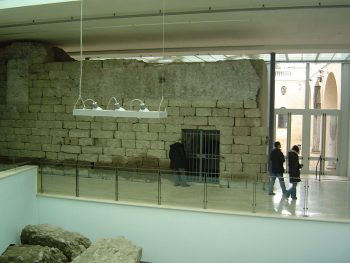
The foundations of the temple of Jupiter Optimus Maximus on the Capitoline hill in Rome. Courtesy of Wkimedia Commons.
Jupiter, as other gods, was invited to attend the banquet. The Ancient Romans were very gracious hosts. They hauled in statues of the gods and reclined them on particularly luxurious couches called pulvinaria. The stony deities were given a share of the best food. They knew, of course, that in the forms the gods were currently in they could not grasp the food much less open their sculpted lips and partake. To solve this some lucky priests which were designated as epulones stepped up. These priests, on this night, had the duty of indulging in the fine food offered to the icons on behalf of the gods, as a sort of “gastronomic proxies”.
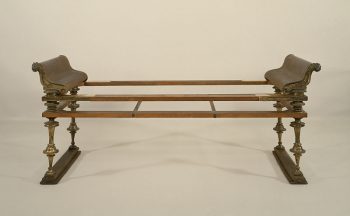
Roman Banquet Couch. Courtesy of Wkimedia Commons.
The Epulum Jovis was held on September 13th because that was its dies natalis. This is the anniversary of the temple’s establishment.
Another ritual was observed on the same day on the grounds of the same temple, however, its connection to the Epulum Jovis or to any other original significance has been faded with time. Even the Romans might have been unsure of the significance of the ritual, but it was performed alongside the festivities.
On the right side of the aedes of Jupiter, the shrine of Jupiter, was a tempulum, a sacred space, dedicated to Minerva.
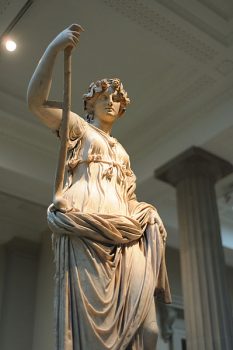
Statue of Minerva, the Roman Goddess. Courtesy of Wikimedia Commons.
In this tempulum the ritual known as clavus annalis took place.
Literally, clavus annalis means “year-nail”. This ritual included driving a nail into a wall of the temple.
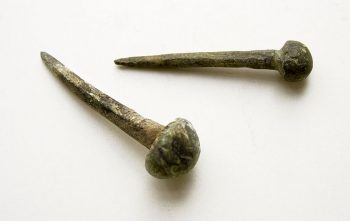
Roman era wrought iron nail. Courtesy of Wkimedia Commons.
Since this ceremony takes place on the dies natalis some have theorized that it was a way of marking the years or the time that was significant to the establishment of the temple.
Yet, according to Livy, this ritual predated the common use of written letters. And as any historian might know, the use of the written letter would have made tracking the history of this ritual much easier. Yet, historians can tell that this ceremony must have had historiographical or chronological importance because the nail-driving was done with association of Minerva, who was credited with the invention of the number.
The metaphor of driving a nail into something was also significant to the Ancient Romans outside of this ceremony. The Romans had a phrase “Clavum fingere“, which literally means “to nail in, to fasten or fix the nail”. The significance of this phrase, however, was tied to the strength of the connection between the nail and the surface. It was a phrase that alluded to the fixing or the “sealing” of fate.

Livius Statue auf der Rampe des Parlaments. Courtesy of Wkimedia Commons.
Livy recalled a more protective superstition surrounding a ceremonial nail-driving. In the early Republic it was associated with the appointment of a dictator clavi figendi causa, translated as “dictator for the purpose of driving the nail”. It is recorded that a dictator was appointed in 363, 331, 313, and 263 BCE. Livy recalled that in 363 Rome had been swept over by a terrible plague which had lingered for two years. After a dictator completed the nail-driving ritual the plague broke.
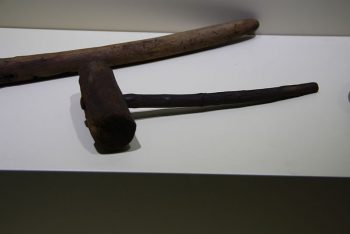
Archaeological Museum in Milan Italy. Ancient Roman wooden hammer. Courtesy of Giovanni Dall’Orto and Wikimedia Commons.
The Romans also adopted another ceremony for nail-driving due to Augustus, who, in 1 AD, revived the tradition and from then on a Roman censor would drive a nail in the wall of a temple at the end of his term. This would have been to mark, historically, the
The significance of the clavus annalis is generally thought to have been a ceremony to mark the years as they passed, given the name of the ceremony, but a little research into the attitudes and rituals of these ancient people reveals a very rich cultural and multilayered understanding of one ceremonial act that spans hundreds of years of history.
Review Terms for This Week!
Epulum Jovis (/Iovis)
pulvinaria
epulones
dies natalis
aedes
tempulum
clavus annalis
“Clavum fingere”
dictator clavi figendi causa
Sources:
Praetor maximus, the chief magistrate with imperium; T. Corey Brennan, The Praetorship in the Roman Republic (Oxford University Press, 2000), p. 21.
Livy, 7.3; Brennan, Praetorship, p. 21.
William Warde Fowler (1899). The Roman Festivals of the Period of the Republic: An Introduction to the Study of the Religion of the Romans. Macmillan. pp. 218–.

Build vocabulary, practice pronunciation, and more with Transparent Language Online. Available anytime, anywhere, on any device.
About the Author: Brittany Britanniae
Hello There! Please feel free to ask me anything about Latin Grammar, Syntax, or the Ancient World.



